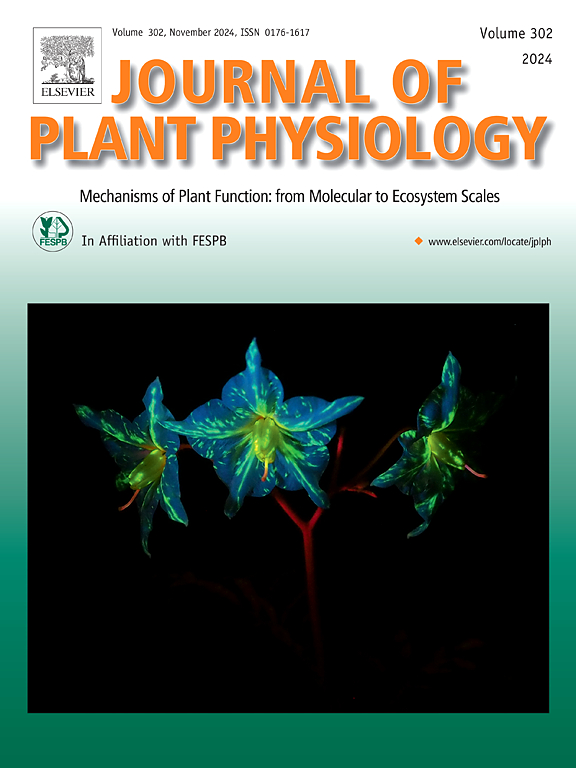AmCERK1 and AmLYK3 interaction mediates CIP-induced defense responses in A. macrocephala
IF 4.1
3区 生物学
Q1 PLANT SCIENCES
引用次数: 0
Abstract
Southern blight caused by Sclerotium rolfsii (S. rolfsii) represents a significant threat to the medicinal plant Atractylodes macrocephala Koidz. (A. macrocephala), with effective control measures remaining limited. Chrysanthemum indicum polysaccharides (CIP) have been identified as an elicitor capable of inducing defense responses in A. macrocephala against S. rolfsii infection. However, the molecular mechanisms underlying CIP recognition remain poorly understood. In this study, comparative transcriptome analysis revealed two potential LysM-receptor kinases, AmCERK1 and AmLYK3, as candidate receptors for CIP recognition. These genes, which are orthologous to Arabidopsis CERK1 and Medicago truncatula LYK3, exhibited significant up-regulation upon CIP treatment. Bimolecular fluorescence complementation (BiFC) assays demonstrated that AmCERK1 and AmLYK3 interact in a CIP-dependent manner. Transient overexpression experiments further confirmed that CIP treatment markedly enhanced the expression of these receptor genes. Virus-induced gene silencing (VIGS) assays indicated that CIP treatment could partially compensate for the suppression of AmCERK1 and AmLYK3, highlighting their critical role in CIP-induced defense responses. Collectively, these findings suggest that AmCERK1 and AmLYK3 form a pattern recognition receptor (PRR) complex essential for CIP perception, potentially facilitating pattern-triggered immunity (PTI) in A. macrocephala. These findings reveal a novel receptor recognition complex comprising AmCERK1 and AmLYK3, offering crucial insights into the mechanisms of innate immune recognition in plants.
AmCERK1和AmLYK3相互作用介导cip诱导的大头a的防御反应
由罗氏菌核菌(Sclerotium rolfsii)引起的南枯萎病是对药用植物苍术的重大威胁。(A. macrocephala),有效的控制措施仍然有限。菊多糖(Chrysanthemum indicum polysaccharides, CIP)是一种能够诱导大头菊对罗氏葡萄球菌感染产生防御反应的激发子。然而,CIP识别的分子机制仍然知之甚少。在这项研究中,比较转录组分析揭示了两个潜在的lysm受体激酶,AmCERK1和AmLYK3,作为CIP识别的候选受体。这些基因与拟南芥CERK1和苜蓿LYK3同源,在CIP处理下表现出显著上调。双分子荧光互补(BiFC)分析表明,AmCERK1和AmLYK3以cip依赖的方式相互作用。瞬时过表达实验进一步证实,CIP处理显著增强了这些受体基因的表达。病毒诱导的基因沉默(VIGS)实验表明,CIP处理可以部分补偿AmCERK1和AmLYK3的抑制,突出了它们在CIP诱导的防御反应中的关键作用。综上所述,这些发现表明AmCERK1和AmLYK3形成了一种模式识别受体(PRR)复合物,对CIP感知至关重要,可能促进大头a的模式触发免疫(PTI)。这些发现揭示了一种由AmCERK1和AmLYK3组成的新型受体识别复合物,为了解植物先天免疫识别的机制提供了重要的见解。
本文章由计算机程序翻译,如有差异,请以英文原文为准。
求助全文
约1分钟内获得全文
求助全文
来源期刊

Journal of plant physiology
生物-植物科学
CiteScore
7.20
自引率
4.70%
发文量
196
审稿时长
32 days
期刊介绍:
The Journal of Plant Physiology is a broad-spectrum journal that welcomes high-quality submissions in all major areas of plant physiology, including plant biochemistry, functional biotechnology, computational and synthetic plant biology, growth and development, photosynthesis and respiration, transport and translocation, plant-microbe interactions, biotic and abiotic stress. Studies are welcome at all levels of integration ranging from molecules and cells to organisms and their environments and are expected to use state-of-the-art methodologies. Pure gene expression studies are not within the focus of our journal. To be considered for publication, papers must significantly contribute to the mechanistic understanding of physiological processes, and not be merely descriptive, or confirmatory of previous results. We encourage the submission of papers that explore the physiology of non-model as well as accepted model species and those that bridge basic and applied research. For instance, studies on agricultural plants that show new physiological mechanisms to improve agricultural efficiency are welcome. Studies performed under uncontrolled situations (e.g. field conditions) not providing mechanistic insight will not be considered for publication.
The Journal of Plant Physiology publishes several types of articles: Original Research Articles, Reviews, Perspectives Articles, and Short Communications. Reviews and Perspectives will be solicited by the Editors; unsolicited reviews are also welcome but only from authors with a strong track record in the field of the review. Original research papers comprise the majority of published contributions.
 求助内容:
求助内容: 应助结果提醒方式:
应助结果提醒方式:


